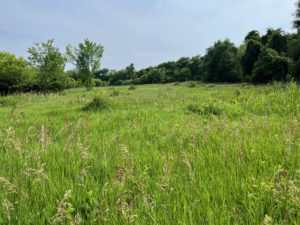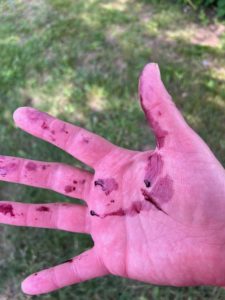Locally Grown Food is Everywhere!
Generally, my idea of foraging is getting up at 2am and looking through every cabinet to see if there might be just one Oreo left. Kidding. But foraging is something I am not super familiar with. I’ve been known to eat the stray blackberry on a hike or head off in search of a paw paw tree now and then, but never anything more serious than that.
Last week our FLF (Favorite Local Farm) posted on Facebook that they were going to host a foraging class and all were welcome. Well don’t you know, I signed right up, and I am so glad I did!
KC Farm School at Gibbs Road

First let me tell you about our FLF, KC Farm School at Gibbs Road. This is a wonderful farm that is central to the community. They host a farmer’s market on Wednesday night that features food from their farm along with other locally grown produce and products. The farm works closely with schools in the area encouraging teachers to bring their students to learn about food and where it comes from. There is a fantastic intern program that teaches students job skills and a work ethic, and all of their produce and classes are “pay what you are able”. Recently, the farm expanded and purchased 11 acres of wild land across the street which is now known as “Common Ground”.
A Class Teaching Foraging For Locally Grown Food

For our foraging class the farm employed the help of Amy Bousman from the Kansas Department of Wildlife and Parks. She led a group of us through Common Ground and taught us which plants were edible, how to harvest them, what time of year they were ready, and also which plants to stay away from. After a delightful hike and foraging session, we headed back to the farm and cooked a delicious treat with the food we found. Amy showed us how to make elderberry flower fritters which we then covered with mulberries and honey. Absolutely decadent!
After spending just these few hours with Amy it amazed me to see how much food is literally all around us. She pointed out that many of the plants we see as weeds were plants that early settlers brought from their home countries because they found them useful for things like medicine and food. Plants as common to us as dandelions, broadleaf plantain, and Queen Anne’s lace are all non-native species that are thought to have been brought here on purpose.
Start Foraging

If you would like to start foraging for your food or to use plants in your holistic health routine, you should first make sure you take a class either specifically on foraging, or at least on plant identification. The first rule of foraging is to check, then double check, then triple check that you have the correct plant. Many plants that are useful for medicine are also deadly if used incorrectly. Some plants have lovely tasting flowers, but the stems will kill you. And other plants have look-alikes that are deadly. For example, Queen Anne’s lace has parts that are edible, but it looks a whole lot like hemlock, and you do NOT want to get those two mixed up.
If you are interested in classes, check with your local wildlife department, community universities, or, like I did, your FLF. Get some knowledge and go forth and forage!
Enjoy!

Recent Comments